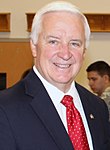| ||||||||||||||||||||
| Turnout | 36.1%( | |||||||||||||||||||
|---|---|---|---|---|---|---|---|---|---|---|---|---|---|---|---|---|---|---|---|---|
| ||||||||||||||||||||
Wolf: 50–60% 60–70% 70–80% 80–90% >90% Corbett: 50–60% 60–70% 70–80% 80–90% >90% Tie: 50% No data | ||||||||||||||||||||
| ||||||||||||||||||||
| Elections in Pennsylvania |
|---|
 |
|
|
The 2014 Pennsylvania gubernatorial election was held on November 4, 2014, to elect the governor and lieutenant governor of Pennsylvania, concurrently with elections to the United States Senate in other states and elections to the United States House of Representatives and various state and local elections.
Incumbent Governor Tom Corbett was defeated by Tom Wolf,[1] becoming the first incumbent Pennsylvania governor to lose re-election since William Bigler in 1854, and the first Republican to ever do so.[2][a] This was the only governorship Democrats flipped in the 2014 midterms. Wolf was sworn in on January 20, 2015, marking the most recent time the Pennsylvania governor's office changed partisan control.
Corbett was considered vulnerable, as reflected in his low approval ratings. An August 2013 Franklin & Marshall College poll found that only 17% of voters thought Corbett was doing an "excellent" or "good" job, only 20% thought he deserved to be reelected, and 62% said the state was "off on the wrong track".[3] Politico called Corbett the most vulnerable incumbent governor in the country,[4] The Washington Post ranked the election as the most likely for a party switch,[5] and the majority of election forecasters rated it "likely Democratic".
Democrats flipped the counties of Erie, Lawrence, Beaver, Alleghany, Greene, Fayette, Cambria, Centre, Clinton, Northumberland, Dauphin, Luzerne, Monroe, Northampton, Carbon, Schuylkill, Lehigh, Berks, Bucks, and Chester. Meanwhile, this is the last time these counties have voted Democratic in a statewide election: Lawrence, Greene, Fayette, Cambria, Clinton, Northumberland, Carbon, and Schuylkill.
This is the first Pennsylvania gubernatorial election since 1982 in which the winner was of the same party as the incumbent president, and the first time since 1934 this occurred during a Democratic administration. This also remains the last time that a Pennsylvania gubernatorial election has been decided by a single-digit margin, as Democrats have won each subsequent election by large double-digit margins. Additionally, it was the most recent election where Pennsylvania voted for a gubernatorial candidate of a different party from fellow Rust Belt states Michigan and Wisconsin.[6]
- ^ "NBC News Projects: PA's Corbett Ousted by Democrat Tom Wolf". NBC News. November 4, 2014. Retrieved November 4, 2014.
- ^ Fitzgerald, Thomas (November 6, 2014). "Wolf defeats Corbett". philly.com. Archived from the original on December 21, 2014. Retrieved August 3, 2022.
- ^ "Franklin & Marshall College poll" (PDF). Franklin & Marshall College. August 28, 2013. Archived from the original (PDF) on September 27, 2013. Retrieved November 13, 2013.
- ^ Schultheis, Emily (May 13, 2013). "Pa. Dems line up to run vs. hobbled Corbett". PoliticsPA. Retrieved May 14, 2013.
- ^ "WaPo: PA-Gov #1 Most Likely to Switch Parties". July 12, 2013. Retrieved November 15, 2014.
- ^ Brownstein, Ronald (September 16, 2024). "Why these three states are the most consistent tipping point in American politics". CNN. Retrieved September 16, 2024.
Cite error: There are <ref group=lower-alpha> tags or {{efn}} templates on this page, but the references will not show without a {{reflist|group=lower-alpha}} template or {{notelist}} template (see the help page).





